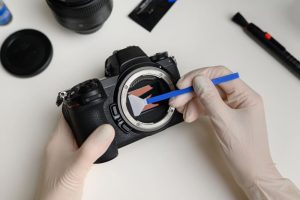
Photography is an art form that relies on precision, patience, and passion. Whether you’re capturing the quiet stillness of a forest at dawn or the vibrant energy of a bustling city, your camera is your closest companion. But as much as your lens tells a story, your camera sensor is the unsung hero behind every clear shot.
Over time, dust and debris inevitably find their way inside your camera body, settling on the sensor. The result? Annoying black spots or smudges on your images that persist regardless of how clean your lens may be. For photographers who value clarity and professionalism, sensor cleanliness is essential. While it may sound intimidating, cleaning your sensor can be safe, straightforward, and satisfying. Here’s how to do it with care and confidence.
Understanding the Camera Sensor and the Signs of Dust
Before diving into cleaning, it helps to understand what the Camera Sensor is and why it gets dirty.
The camera sensor is a delicate electronic component that captures light and converts it into an image. In mirrorless or DSLR cameras, every time you change your lens, you risk exposing the sensor to dust particles. Even in tightly sealed camera sensor, microscopic dust can sneak in over time.
The first signs of dust are usually:
- Dark, fuzzy spots in the same place on every image, especially visible against light backgrounds.
- A decrease in image sharpness or clarity, especially around detailed textures.
- A stubborn mark that persists after cleaning your lens or filter.
To confirm sensor dust, switch your camera to a narrow aperture (like f/16 or f/22), take a photo of a plain white wall or clear sky, and inspect the image. If you see consistent marks, it’s time for a cleaning.
The Golden Rule: Be Gentle
Sensor cleaning is delicate work. One wrong move could result in scratches, damage, or worse—voiding your camera’s warranty. That’s why it’s important to follow a structured, gentle, and step-by-step process using the right tools.
Step-by-Step: How to Clean Your Camera Sensor
Step 1: Preparation is Key
What you’ll need:
- A fully charged battery (your camera must not die mid-clean!)
- A clean, dust-free environment (avoid cleaning in windy or dusty areas)
- A hand blower (like a Giottos Rocket Air Blaster)
- Sensor swabs (specific to your sensor size: APS-C, full-frame, etc.)
- Sensor cleaning fluid (only a few drops are needed)
- Optional: A sensor loupe (a magnifier with built-in light)
Step 2: Use the Camera’s Sensor Cleaning Mode
Most modern cameras have a “Sensor Cleaning “ mode in their settings. This vibrates the sensor at high speed to shake off minor dust particles. Run this process first—it might solve the problem without manual cleaning.
“ mode in their settings. This vibrates the sensor at high speed to shake off minor dust particles. Run this process first—it might solve the problem without manual cleaning.
If dust persists, proceed to manual cleaning.
Step 3: Air Blower – The First Line of Defense
Remove your lens and turn your camera sensor on to activate the manual sensor cleaning mode, which locks the mirror up and exposes the sensor (if using a DSLR).
Important: Hold the Camera Sensor facing downward to let gravity help dislodge dust. Use the hand blower to blow several short bursts of air across the sensor. Never use canned air—it can release moisture or chemicals that may damage the sensor.
Avoid touching the sensor at this stage. Sometimes, a few puffs of clean air are enough.
Step 4: Dry Swabbing – For Persistent Dust
If the air blower doesn’t clear the Camera Sensor, you’ll need to use a dry sensor swab. These swabs are specially designed to match your sensor size.
Open a swab from its sealed pouch (never reuse one). Gently place it at one side of the sensor, then slowly and evenly drag it across to the other side in a single, smooth motion. Flip it and swipe back using the clean side.
Never apply pressure. Let the swab glide.
Step 5: Wet Swabbing – For Smudges or Oil Spots
If dry swabbing still leaves marks, your sensor may have oil or moisture spots. This requires a wet clean.
Add just one or two drops of sensor-cleaning solution to a clean swab. Repeat the swabbing technique: smooth, single-pass strokes. Avoid over-saturating the swab—too much fluid can leave streaks or seep into the edges of the sensor.
After swabbing, let the sensor dry for a few seconds. Inspect with a loupe or take another test shot to see if the problem is resolved.
What NOT to Do
Even experienced photographers make mistakes when cleaning. Here are some critical don’ts:
- Don’t use cotton swabs, tissues, or household wipes. These materials can shed fibers or scratch the surface.
- Don’t blow air with your mouth. Moisture can easily fog or stain the sensor.
- Don’t panic if the first clean isn’t perfect. Sometimes two or three gentle swabs are needed.
- Don’t touch the sensor with your fingers. Skin oils are extremely hard to remove.
Professional Cleaning vs. DIY
If you’re unsure or nervous, many camera shops and service centers offer professional Camera Sensor cleaning. It can cost anywhere from $30 to $100, depending on your location and camera type, but it guarantees peace of mind—especially if your gear is under warranty.
DIY cleaning is perfectly safe if done correctly, and it saves both time and money in the long run.
Tips to Prevent Sensor Dust
- Change lenses quickly and in clean environments. Try to point the camera body downward during lens swaps.
- Keep your camera bag clean. Dust builds up inside bags and transfers to your gear.
- Use a body cap when no lens is attached.
- Store in a dry, clean place with silica gel packs to absorb moisture.
Conclusion: A Clear Sensor for a Clear Vision
Cleaning your camera sensor may feel like a daunting task at first, but with patience, the right tools, and a steady hand, it becomes a manageable—and even satisfying—part of your photography routine. Just as a painter cleans their brushes, a photographer must care for their tools. Every dust-free image you capture will serve as a reminder of the attention and love you give to your craft.

2 thoughts on “How to Clean Camera Sensor: Safely and Effectively”